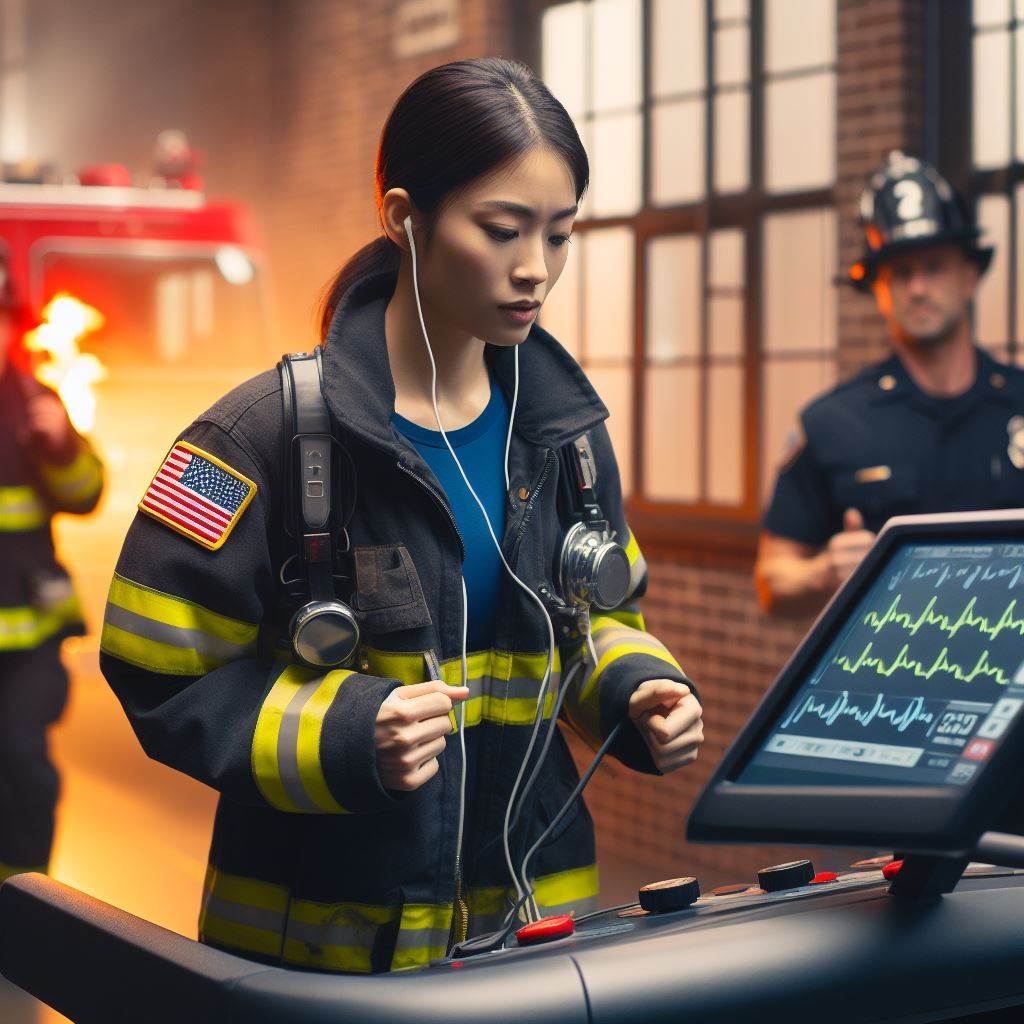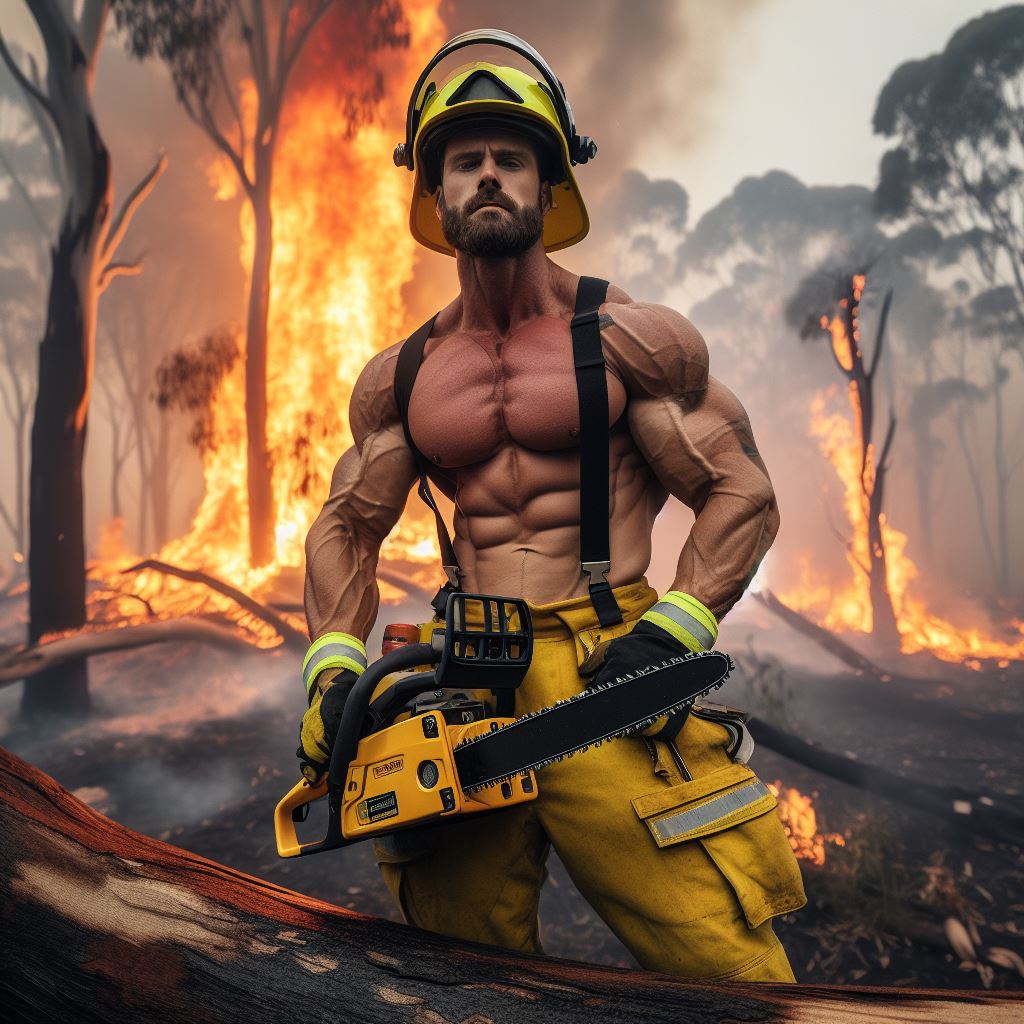Introduction
In the pulsating heart of emergency response, where the clash between firefighters and the relentless blaze unfolds, physical fitness transcends a mere regimen—it transforms into the unspoken covenant between survival and sacrifice.
This section undertakes a comprehensive odyssey, peeling back layers to illuminate the profound interdependence of firefighter fitness with the formidable challenges that these modern-day heroes confront daily.
As the wail of sirens orchestrates the beginning of another firefighting saga, it’s imperative to decipher the nuanced dimensions of why physical fitness isn’t just a superficial attribute for firefighters.
It stands as the bedrock, the underlying force empowering them to navigate treacherous landscapes, endure the grueling conditions, and ultimately triumph over the adversities of the battlefield.
This introduction serves as a mere prologue to an intricate journey through the labyrinth of firefighter fitness, seeking to understand its profound implications.
We’re poised to unravel its indispensable role, explore the transformative impact it casts on those who willingly confront the flames, and underscore the imperative of maintaining peak physical condition in the demanding and unpredictable realm of firefighting.
The physical demands of firefighting
The physical challenges faced by firefighters
Firefighters endure physically demanding tasks to ensure the safety and well-being of their communities. They face numerous challenges that require strong physical fitness and endurance.
- Heat and smoke exposure: Firefighters frequently encounter intense heat and smoke while battling fires. They need to be physically prepared to withstand these harsh conditions.
- Heavy lifting and carrying: Firefighters are required to carry heavy equipment, such as hoses, axes, and ladders, which can weigh up to 100 pounds or more. They need to possess considerable strength to handle these loads effectively.
- Climbing and maneuvering: Firefighters often need to climb multiple flights of stairs or ladders, and maneuver through confined spaces to rescue individuals or extinguish fires. Agility and flexibility are crucial skills to navigate such challenging environments.
- Physical exertion under stress: Firefighters must perform physically demanding tasks while under immense pressure and stressful circumstances. Fitness and endurance are essential to stay focused and perform optimally.
Need for specific training and fitness routines
Given the nature of their job, firefighters must prioritize their physical fitness and undergo specific training routines to meet the physical demands of firefighting.
- Cardiovascular fitness: Firefighters engage in high-intensity activities that require a strong cardiovascular system. Regular cardiovascular exercises such as running, cycling, or swimming should be incorporated into their training regimen.
- Strength training: Building and maintaining strength is crucial for firefighters to handle heavy equipment and perform rescue operations. Weightlifting, bodyweight exercises, and functional movements should be included to enhance their overall strength.
- Endurance training: Endurance plays a critical role in firefighting, as these individuals often work for extended periods without rest. Engaging in activities that improve endurance, such as circuit training, interval training, and stair climbing, is beneficial.
- Flexibility and mobility exercises: Firefighters need to have good flexibility and mobility to navigate through tight spaces or perform demanding tasks. Stretching, yoga, and mobility drills should be incorporated into their routines to enhance flexibility.
- Core strength: A strong core is essential for firefighters to maintain stability, balance, and proper body mechanics while carrying heavy loads or performing physically challenging tasks. Exercises like planks, Russian twists, and medicine ball workouts can help strengthen the core muscles.
Essentially, firefighting is an incredibly demanding profession that requires firefighters to possess exceptional physical fitness. They face various physical challenges such as heat exposure, heavy lifting, climbing, and exertion under stress.
Specific training routines focusing on cardiovascular fitness, strength, endurance, flexibility, mobility, and core strength are necessary to ensure firefighters can perform their duties effectively and safely.
By prioritizing their physical fitness, firefighters can better serve their communities and mitigate the risks associated with their occupation.
Read: Understanding Ranks in Australian Police Force
Components of firefighter fitness training
Firefighter fitness isn’t just about strength; it’s a multifaceted approach encompassing cardiovascular endurance, strength, flexibility, and mobility.
Cardiovascular Endurance
Importance for prolonged exertion during firefighting
When battling flames, firefighters encounter physically demanding situations. Cardiovascular endurance emerges as a fundamental component, ensuring sustained effort over extended periods.
Prolonged exertion during firefighting demands robust cardiovascular endurance, vital for stamina on the frontline.
Types of Cardiovascular Exercises Suitable for Firefighters
- Running
- Cycling
- Rowing
- Swimming
- Aerobic classes
Strength Training
Importance for carrying heavy equipment and rescuing victims
Firefighters often face scenarios demanding considerable physical strength. A robust strength training regimen becomes imperative for meeting these challenges head-on.
Recommended Exercises to Build Strength and Muscular Endurance
- Compound Exercises: Engage multiple muscle groups simultaneously, enhancing overall strength. Squats, deadlifts and bench press are examples of compound exercises.
- Functional Training: Mimic firefighting movements to improve muscular endurance and reinforce practical strength.
Flexibility and Mobility
In the unpredictable realm of firefighting, agility and flexibility are paramount. Flexible firefighters can maneuver efficiently through confined spaces and execute tasks with precision.
Benefits of Flexibility for Firefighting Tasks
- Improved Range of Motion: Facilitates fluid movement, crucial for navigating diverse emergency situations.
- Injury Prevention: Enhanced flexibility reduces the risk of injuries, ensuring firefighters remain agile and resilient.
Stretching Techniques to Improve Flexibility and Mobility
- Dynamic Stretches: Active stretches prepare muscles for dynamic movements, aligning with the unpredictability of firefighting tasks.
- Yoga and Mobility Exercises: Embrace practices that enhance joint mobility, promoting agility and adaptability on the fireground.
In essence, firefighter fitness training goes beyond the conventional. It’s a holistic approach, recognizing the multifaceted demands of the profession.
By incorporating cardiovascular endurance, strength training, flexibility, and mobility exercises, firefighters not only prepare for the physical challenges but also cultivate the resilience needed to navigate the unpredictable nature of their critical roles.
Read: How to Become a Police Officer in Australia
Nutrition for firefighter fitness
Importance of proper nutrition for energy and recovery
Proper nutrition plays a crucial role in ensuring firefighters have the energy and stamina needed for their physically demanding jobs. A balanced diet can help provide essential nutrients and promote muscle recovery after intense workouts.
By fueling the body with the right nutrients, firefighters can optimize their performance and reduce the risk of injuries.
Recommended dietary guidelines for firefighters
- Adequate protein intake: Protein is vital for muscle repair and rebuilding. Firefighters should consume lean sources of protein such as chicken, fish, and beans.
- Complex carbohydrates: Carbohydrates are the body’s primary source of energy. Firefighters should choose whole grains, fruits, and vegetables to fuel their workouts.
- Healthy fats: Healthy fats, like those found in avocados and nuts, provide long-lasting energy and aid in the absorption of fat-soluble vitamins.
- Hydration: Staying hydrated is essential for optimal performance. Firefighters should drink water throughout the day to prevent dehydration.
- Nutrient timing: Eating a balanced meal 2-3 hours before exercise and snacking on a small, protein-rich snack afterward can enhance recovery.
Pre- and post-workout nutrition tips
Pre-workout
- Consume a balanced meal rich in carbohydrates and lean protein to fuel the body for exercise.
- Consider eating a small, easily digestible snack 30 minutes before working out for an extra energy boost.
Post-workout
- Refuel with a snack or meal within 30 minutes of exercise to replenish glycogen stores and accelerate muscle recovery.
- Aim for a combination of carbohydrates and protein, such as a fruit smoothie with Greek yogurt or a turkey sandwich on whole wheat bread.
Hydration
- Rehydrate with water or a sports drink after a workout to replace lost fluids and electrolytes.
- Monitoring urine color is a simple way to determine hydration status: pale yellow indicates proper hydration.
Generally, proper nutrition is integral to firefighter fitness. By following recommended dietary guidelines and incorporating pre- and post-workout nutrition tips, firefighters can maximize their performance, promote muscle recovery, and reduce the risk of injuries.
Remember to fuel your body with the right nutrients and stay hydrated to excel in the demanding role of a firefighter.
Your Personalized Career Strategy
Unlock your potential with tailored career consulting. Get clear, actionable steps designed for your success. Start now!
Get StartedRead: Diplomatic Immunity: The Basics

Injury prevention and recovery
Common injuries among firefighters
- Sprains and strains from lifting heavy equipment and performing physical tasks.
- Back injuries due to repetitive movements and carrying heavy loads.
- Burns and smoke inhalation from firefighting operations.
- Heat-related illnesses like heat exhaustion and heat stroke.
- Fractures and dislocations from falls and accidents during emergency response.
Strategies for preventing injuries in training and on the job
- Engage in regular physical fitness training to improve strength and endurance.
- Practice proper lifting techniques and use assistive devices when necessary.
- Wear appropriate protective gear, including helmets, gloves, and fire-resistant clothing.
- Follow safety protocols during training exercises and emergency operations.
- Maintain a healthy diet and stay hydrated to support overall physical well-being.
- Implement regular stretching and warm-up routines before engaging in physically demanding tasks.
Techniques for effective recovery and rehabilitation
- Seek immediate medical attention for any injuries or symptoms of illness.
- Rest and avoid putting additional strain on injured body parts.
- Follow prescribed rehabilitation exercises and therapies to aid in recovery.
- Consider using ice and heat therapy to reduce pain and inflammation.
- Use support devices, such as crutches or braces, as directed by medical professionals.
- Engage in low-impact exercises, like swimming or cycling, to maintain cardiovascular fitness during recovery.
- Attend regular follow-up appointments and communicate progress and concerns with healthcare providers.
Ultimately, preventing injuries among firefighters is crucial for their overall well-being and ability to perform their duties effectively. By following strategies such as proper training, utilizing safety gear, and maintaining physical fitness, firefighters can reduce the risk of common injuries.
However, should injuries occur, prompt medical attention and effective recovery techniques are essential for a full return to duty.
Read: Crisis Management in Diplomacy
Mental health and wellness for firefighters
The impact of stress and trauma on firefighters
- Firefighters often face high levels of stress and trauma in their line of work.
- The constant exposure to emergencies and life-threatening situations can take a toll on their mental health.
- Repeated exposure to traumatic events can lead to conditions like post-traumatic stress disorder (PTSD).
- Firefighters may also experience symptoms of anxiety, depression, and sleep disorders due to the nature of their job.
- It is essential to recognize and address the impact of stress and trauma on firefighters’ mental well-being.
Strategies for maintaining mental well-being
- Developing healthy coping mechanisms is crucial for firefighters to manage stress effectively.
- Regular exercise and physical activity can help reduce symptoms of anxiety and depression.
- Engaging in relaxation techniques such as deep breathing exercises or meditation can promote mental calmness.
- Creating a support network among fellow firefighters can provide an outlet for sharing experiences and emotions.
- Seeking professional help through therapy or counseling is beneficial for managing mental health challenges.
Resources and support for firefighters’ mental health
- Fire departments should prioritize mental health initiatives and provide access to adequate resources.
- Implementing peer support programs within fire departments can help create a supportive environment.
- Education and training about mental health should be a part of firefighter training programs.
- Firefighters should be aware of available mental health resources such as hotlines or counseling services.
- Support from family, friends, and loved ones is crucial for firefighters’ overall well-being.
Basically, ensuring the mental health and wellness of firefighters is as important as their physical fitness. Recognizing the impact of stress and trauma, implementing strategies for maintaining mental well-being, and providing resources and support are vital.
Fire departments play a significant role in promoting a culture that prioritizes mental well-being and creates an environment where firefighters can seek help without stigma.
By addressing mental health challenges, firefighters can better cope with the demands of their profession and continue saving lives with resilience and strength.
Find Out More: Day in the Life of an Aussie Politician: An Inside Look
Conclusion
Throughout this blog post, we have highlighted the importance of firefighter fitness and provided training tips to help firefighters stay in optimal physical condition. We have emphasized the significance of cardiovascular endurance, strength training, and flexibility in maintaining overall fitness.
Additionally, we discussed the importance of proper nutrition and hydration in supporting firefighter performance. We explored various exercises and training techniques that can be incorporated into a firefighter’s fitness routine, such as circuit training, interval training, and functional movements.
Furthermore, we addressed the importance of mental wellbeing and stress management for firefighters. We emphasized the need for adequate rest and recovery to prevent burnout and reduce the risk of injuries.
In closing, maintaining a high level of fitness is essential for firefighters to perform their duties effectively and safely. By following the training tips provided in this blog post, firefighters can enhance their physical abilities and minimize the risk of injuries on the job.
Remember, consistency is key. Make a commitment to prioritize your fitness and establish a regular exercise routine. Seek support from fellow firefighters and fitness professionals to stay motivated and accountable.
As you embark on your firefighter fitness journey, bear in mind that it is a lifelong endeavor. Embrace the challenges, celebrate the milestones, and constantly strive for improvement. Your dedication to fitness will not only benefit you but also inspire others within your profession.
Stay strong, stay fit, and stay safe. Your commitment to firefighter fitness is commendable and crucial in ensuring the well-being and success of both yourself and your team.
Stand Out with a Resume That Gets Results
Your career is worth more than a generic template. Let us craft a resume and cover letter that showcase your unique strengths and help you secure that dream job.
Get Hired



